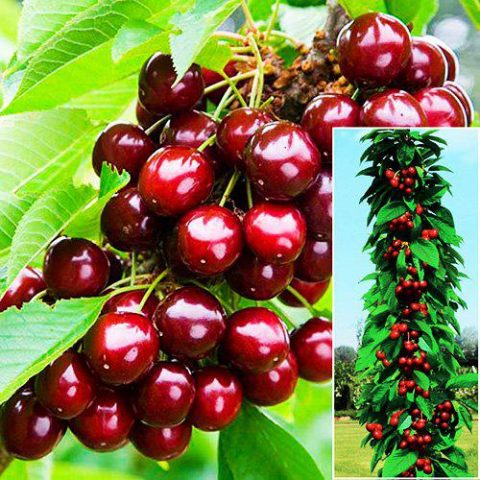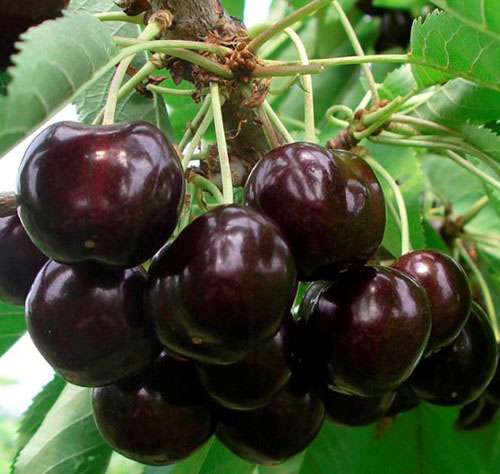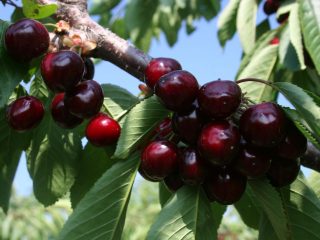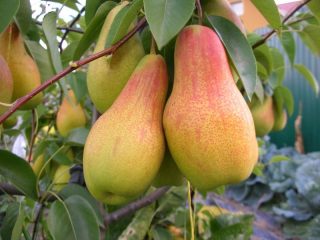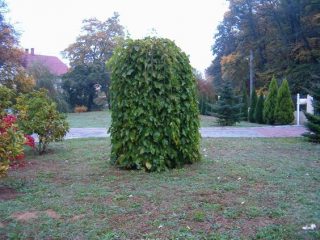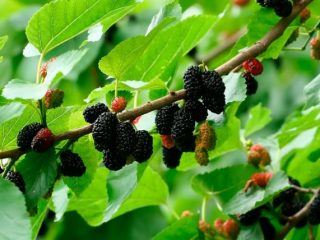Content
- 1 Is there a columnar cherry
- 2 Description of columnar cherries
- 3 Columnar cherry: description of varieties with photos
- 4 Columnar cherry varieties for regions
- 5 Columnar cherry: planting and care
- 6 Pruning columnar cherries
- 7 How to Grow Columnar Cherry in a Container
- 8 Advantages and disadvantages of columnar cherries
- 9 Conclusion
- 10 Testimonials
Columnar cherry is a compact plant that will yield a sufficient number of berries, and it will take much less space than ordinary cherries. It will not be superfluous to plant them on your site.
Is there a columnar cherry
Modern farmers use the pillar shape for various fruit trees. Not spared this trend and cherries. For the first time in Canada in 1964, an apple tree with a similar mutation was discovered. European breeders took this into service and began to conduct experiments with other fruit crops.
Description of columnar cherries
Columnar cherry trees are formed in the shape of a cylinder. The crown grows up, the side branches are cut off, forming a column a meter in diameter.
What does columnar cherry look like?
The plant has a small volume. The crown circumference is one meter, the height of the columnar cherry is 2-3 meters. The plant is strewn with berries, little leafy.
The root system of a columnar sweet cherry
The roots are of sufficient depth, but they do not grow in breadth beyond the crown.
Yield
Each plant provides 15 kg of berries, depending on the species. Petioles cover the trunk, making it look like an ear of corn.
Resistance to diseases, pests, frost
The culture loves warm climates. For her, the southern and central regions of Russia are suitable. In northern latitudes, you should take care of winter shelter.
Breeders make varieties immune to diseases and pests. Still, there are cases of damage by coccomycosis and insects.
Columnar cherry: description of varieties with photos
This plant is less recognized in Russia than apple and pear. There are varieties that are grown in different regions of the country, depending on their quality.
Popular varieties of columnar cherries:
- Helena;
- Silvia;
- Sam;
- Queen Mary;
- Black;
- Little Sylvia;
- Jealous;
- Sabrina.
Below are their characteristics.
Helena
Dessert, bright red berries, weight 2-14 g. The tree is high, up to 3.5 meters, the crown is a meter in diameter. High-yielding species, bears fruit from June 15-20 during the week. It continues to bear fruit for up to 20 years.
Silvia
Similar in characteristics to Helena. The tree and fruit sizes, yield and taste are the same. Selena of early maturity - from June 12-18. She has a shorter fruiting period - 15 years.
There is a Little Sylvia variety with a height of no more than 2 m.
Below is a photo of a red columnar Sylvia cherry.
Sam
The earliest variety. It becomes ripe before June 12, berry weight 12 g, fruiting period 15 years. Serves as a pollinator for different varieties of this crop.
Queen Mary
Dessert, not too cold-resistant. Grown in the middle lane. The annual harvest is 15 kg.
Black cherry
Columnar black cherry is famous for its high yield, large berries and frost resistance. Unpretentious view, compact, no higher than 2 meters.
Jealous
She has sweet juicy berries. They are well stored and transported. Frost-resistant variety. Disadvantage - smallish berry - 8 g. Ripens in early July.
Sabrina
It is a self-pollinated columnar cherry. High volumetric tree. A productive variety, sweet berries. Low cold resistance. Good immunity to diseases and pests.
Columnar cherry varieties for regions
To wait for the harvest of berries, you need to choose the right variety for the place of its cultivation. The main thing is its frost resistance and berry picking time.
Columnar cherry for Moscow region
Varieties that are sufficiently frost-resistant, with low requirements for growing conditions, are suitable. These are Sam, Sylvia, Helena, Black, Revna.
Columnar cherry varieties for Siberia
Cold-resistant varieties Revna and Black are planted in Siberia. They are immune to disease and rarely attacked by pests. Columnar cherries should be planted in this region in spring.
Columnar cherry for the Urals
The climate in the Urals and Siberia is quite similar, so they choose the same varieties - Revna and Chernaya.
What varieties of columnar cherries are suitable for central Russia
Here varieties are grown that are not very cold-resistant, but at the same time they are quite unpretentious.
This is Sabrina, Queen Mary, Little Sylvia.
Yellow columnar sweet cherry bears fruit abundantly.
Columnar cherry: planting and care
It can be planted in spring or autumn.
Planting columnar cherries in spring
Rules for planting columnar cherries in spring:
- The best location would be a flat area that is not shaded by buildings or tall plants. Low marshy places with close groundwater are not suitable.
- The soil needs sandy loam, fertilized with humus, with low soil acidity. Lime or dolomite flour is added to acidic soil.
- Pits are made 50 x 50 x 60 cm, with a mound of fertile land in the center. A seedling is placed on a mound, spreading the roots.
- The roots are covered with earth and watered. The surface is mulched to avoid crusting. Columnar cherries are planted at a distance of one and a half meters. Adjacent rows are placed every three meters.
Cultivation of columnar cherries
Columnar cherry care is common for fruit trees. The main dressing is done twice a season. The first is done at the end of March with dry fertilizers in the snow. Complete complex fertilizer is applied. In August, fertilizing is done with mixtures that do not contain nitrogen.
Watering is important. This plant requires a lot of water to form berries. It is important to monitor the condition of the soil around the tree. To retain moisture, the soil around the tree is mulched or tinned.
Pruning columnar cherries
In the first year of plant growth, the top of the seedling is cut off, leaving an increase of 20 cm, the lateral shoots are cut at a distance of 12 cm from the trunk. The same distance is left between them. Columnar formation of sweet cherries is carried out in July.
In the 2nd year, the shoots are pinched 20 cm from the trunk, they give it an increase of 30 cm.
In the third year, the lateral shoots are pinched again, stepping back from the trunk 35-40 cm. The central shoot is allowed to grow 25 cm and in July the top is cut off.
In the 4th year in the spring, it is necessary to cut the columnar cherry, thinning the side branches, cut out thin and growing inward.
By the 5th year, the tree should reach a height of 2-3 meters, further growth is limited. In July, pinch the green side shoots and thin them out.
Starting from the age of 6, every three years they do sanitary pruning of columnar cherries in the spring.
Processing of columnar cherries from diseases and pests
For prophylaxis in April, the kidneys are sprayed with Bordeaux mixture (1% solution). This will protect against fungal diseases. The processing is repeated after flowering in May.
Summer treatment with iron sulfate is protection against pests and diseases, feeding with microelements. It is good to use drugs "Horus", "Skor" for the treatment of clasterosporiosis. Spray at the beginning of budding, repeat after flowering.
In autumn, before leaf fall, the tree trunk zone is treated with urea (0.6 kg / 10 l of water). The leaves are collected and burned.
How to Grow Columnar Cherry in a Container
The seedlings are planted in a 15 liter pot. The soil is made loose and light, arrange drainage in the pot. The soil mixture is enriched with mineral fertilizers.
A tree planted in spring will begin bearing fruit the following year. Of the first flowers, the largest ones are left after 10 cm. Self-fertile columnar cherries are used for containers.
The container plants are pruned and formed. The dimensions of the tree should be smaller than in the ground. The maximum height is made one and a half meters. Lateral shoots are left no more than half a meter long.
Water the plant as the soil dries up, feed it every 10 days during the growing season. In winter, container trees are placed in a cool room and rarely watered. In the spring they take it out into the street. Low-growing varieties are used for growing in containers. Little Sylvia would be a good choice.
Advantages and disadvantages of columnar cherries
The pros and cons of a columnar black cherry, like any plant, exist.
The advantages are as follows:
- Compactness. A good harvest of berries can be obtained from a smaller area.
- Decorativeness. A tree looks very unusual, with red berries scattered right along the trunk.
- These are mainly early ripening varieties, tasty fruits can be obtained in early summer.
- Convenience of picking berries.
The disadvantages include the complexity of care, which consists in the need for annual formation of the crown of the tree in the first years of development, as well as a relatively low yield in relation to the occupied area.
Conclusion
Columnar cherries are just beginning to gain popularity among Russian gardeners. But whoever tried to do this will no longer give up on it. This is a good solution for small garden areas.

